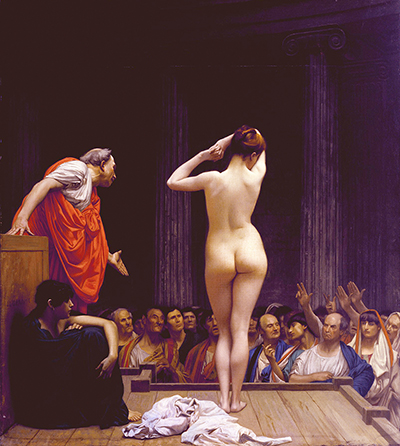A Roman Slave Market is an oil on canvas painting painted by Jean-Leon Gerome in 1884. The image has a size of 64.1cm x56,9cm and depicts a scene of a slave trader trying to sell two slaves (a lady and a young man) on a platform.
In the front side of the platform are a crowd -mostly men and a few women all looking at the naked woman standing on the platform. The naked woman is facing the crowd, and her backside is left for the viewer. The young man sited on the platform next to the trader is covered in a sheet and seems to be terrified as he is next in line. Next to the young man is a white sheet that was covering the naked woman. The naked woman seems humiliated and covers her face with her right wrist, and some people among the crowd are raising their arms ready to give their bids.
The scene in the artwork could be ancient Rome or the 19th century Istanbul. In the image, Gerome depicts different facial expression among the subjects such as humiliation for the naked woman, fear in the sited young man and desire in the people among the crowd. The main subject in the painting seems to be the naked woman who attracts who also attracts viewers’ attention before they learn the details of the art.
The current location of the painting is in the Walters Art Museum in Baltimore. Some of the previous owners of the paintings include Boussod Valadon and James B. Haggin before Henry Walters purchased it in 1917. Henry Walters later bequeathed it to the Walters Art Museum of Baltimore. Most of Gerome’s art was themed in ancient Rome and seemed to combined romanticism, classism and realism. The technique that attempts to combine the two styles of Romanticism and Neoclassicism is referred to as Academicism. Gerome’s artwork also had a smooth style and a precise linear drawing that left no trace of painting work.
Gerome had a lot of interest in art that his father tried to discourage him from studying to become a painter, but he continued. He studied painting under Paul Delaroche as his teacher, but his interest in ancient Rome could have grown when he followed his teacher—Paul Delaroche to Rome. Gerome was lucky to Visit Pompeii and Herculaneum when new excavations were taking place. The uncovered sculptures inspired him into Roman History and continued with Roman History themed paintings even after going back to France.




